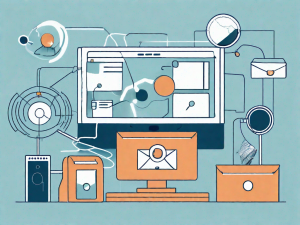In recent years, customer experience (CX) has become a term and focal point of marketing plans for businesses of all sizes and sectors. In addition, CX is becoming increasingly important to compete successfully in the market and maintain high levels of customer satisfaction.
Good CX has to be a priority if your business focuses on customer support and email marketing. This will set you apart from the competition.
The Meaning Of The Term Customer Experience
Basically, customer experience (CX) is a broad term that includes all interactions between a customer and a company. It actually refers to the period from the first moment of awareness until the current moment. That consists of moments prior, during, and following a purchase, provided service, or experience.
For example, consider CX as a customer journey with several touchpoints between the consumer and the company so that you can understand it better. That said, the customer journey consists of sequential phases, activities, questions, and potential barriers. These moments of direct engagement are known as touchpoints. And you can see their range from the product itself to conventional customer service.
The Advantages Of Customer Experience Research
For starters, your entire organization needs to understand the impact of positive CX to develop an efficient and successful strategy.
Customer experience influences the chances of consumers promoting your business to their friends and the likelihood of them becoming your customers. It also has an indirect impact on your employee experience.
As per Forrester’s research, brands that focus on customer experience management have a 14% edge over those that don’t focus on CX research and usability testing.
In addition, it can help you lower the cost to acquire and serve a customer by better understanding and servicing your customers. That, in return, will result in increased revenues.

Social Media and Customer Experience
Customers are constantly connecting with brands through various platforms, including websites and social media. Because of that, the importance of CX research is increasing.
According to recent statistics, customers use different channels at different times of their journey. For example, users can discover your company on social media because of your specific product or article. Then, they can go and visit your website or use Google to get more information before making a purchase.
You can also follow UI design trends for your site to look more appealing and use social media to connect with customers. In addition, try to prioritize engagement and interaction. All this can help your company recognize potential customers and help in creating an excellent experience for them.
Develop A Customer Experience Strategy
While each company’s approach to developing a customer experience strategy is different, several basic elements are universally important for every brand’s process.

“CXM = The art and science of coaxing lifetime loyalty from daily transactions.” – Steve Curtin
1. CX Research
For starters, the best approach to learn about your customers is to do detailed research. That is the first stage of your CX campaign.
From surveys to analytics, you should use both quantitative and qualitative data. In addition, pay attention to personalities and behaviors, and you’ll be able to grasp a better knowledge of your consumers’ needs. For example, Hotjar alternatives are one of the best strategies to boost your website’s total conversion rate and track customer behavior and needs.
Try to evaluate the following data when you’re doing the research:
- CSAT (Customer Satisfaction Score) – is determined using simple survey feedback.
- Accessibility – how easily clients can locate what they’re looking for on your company’s website.
- Intention and goal realization – what users expect from your brand and whether they think you can meet their goals.
- Response time – how fast your firm serves consumers, replies to questions, and more.
- Referrals rate – an indicator of loyalty.
- Metrics based on numbers – visited pages, time on the website, and conversion rate, for example.
2. Create Journey Maps For Your Customers

Create a customer journey map once you’ve collected and evaluated your client data and created several profiles for your users base.
A customer journey map visualizes a customer’s interaction with a brand, its products/services, and staff. The personas you use to describe the present customer experience guide the map’s members uniquely.
You can design an example user based on your research findings. To help them come to life, give them a name as well as some identifying details.
For example, Katie Smith:
- Age and gender: 30-year-old woman
- Location: Manhattan, New York
- Role: Production manager
- Motivators: Solving problems, software
- Hobbies: Running, playing guitar, and gardening
So, the primary benefit of this map is that it visually organizes the points of contact between the client and your company. Some of the examples are emotional responses, needs, pain points, and more.
Moreover, journey maps give your company insight into possible customer decision-making situations, in addition to helping them better understand the factors that affect customers’ purchasing decisions.
To be more precise, this kind of mapping creates a perspective of the customer experience and discovers every flaw in your current strategy.
3. Your Current Staff Can Help Build Your CX
Employees concerned about the customer’s experience and happiness and those who have a customer-centric mindset are crucial.
A simple phone conversation with a real person can provide unexpected insight into how your CX strategy performs. Verify that your customer service team can share gathered data. Also, try to motivate product managers to seek key customers and schedule open-ended meetings.
Take into account your company’s culture as well. For example, are all of the company’s leaders and employees on the same page? Do they share clearly defined values that support positive customer experiences? Is there anything you can do to make your company more user-centric?
Focus on your current team as their motivation, or lack of motivation can have an impact on your users’ experience.
4. Execute Your CX Strategy

“No longer will people accept viral marketing. What consumers are expecting — and craving — is a more personalized, curated experience.” – Penny Wilson
You can now freely take action after you’ve completed your research and have your goals set.
A Customer Experience Management (CEM) program should be the core of your executive strategy. With that program, you can manage and measure customer interactions at all contact points. In addition, using such technology and coordinating tasks among your team will make the experience management process go smoothly.
Among the most important CX technologies are:
- Self-service
- Live chat
- Mobile support
- Social support
- Omnichannel support
The future of customer experience
“You’ve got to start with the customer experience and work back toward the technology, not the other way around.” – Steve Jobs
Artificial intelligence (AI) will drive Customer Experience Management (CEM) in the future. The technologies can work together to automate repetitive operations and make them easier. As a result, human workers will be freer and get all the AI insight to help them quickly resolve client issues.
These improvements will effectively identify frustrated and dissatisfied users and those who could be on the verge of switching to a competitor. In addition, AI will immediately forecast who these consumers will be and step in early to prevent those issues.
CX Research as Marketing
As we all know, customers now have higher expectations than ever, and your company should change its strategy accordingly. Moreover, as the user gains more influence, the customer experience becomes increasingly more important.
Customer experience is an area that needs constant nurturing and care. With that in mind, if your organization places a big emphasis on CX research, you will see a rise in customer loyalty, retention, and revenue growth.




